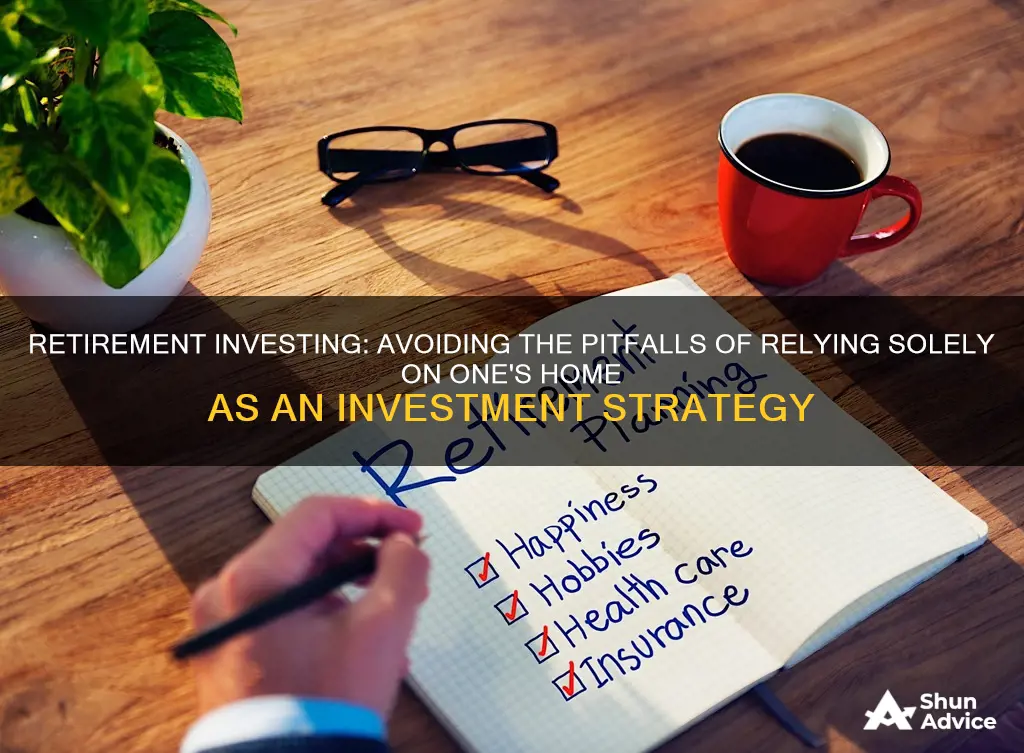
Investing for retirement is a long-term strategy that requires careful planning and a good understanding of the various investment options available. While there is no one-size-fits-all approach, there are several strategies that are generally not recommended for successfully investing for retirement.
One such strategy is making emotional or fear-driven investment decisions. It is important to keep emotions in check and avoid making rash decisions based on short-term market fluctuations. Another pitfall to avoid is putting all your eggs in one basket, so to speak. Diversification is key to reducing risk and enhancing the potential for long-term gains. Not paying attention to fees associated with investments is another common mistake. These fees can significantly eat into your retirement funds over time.
Starting early and understanding your options are crucial components of a successful retirement investment strategy. It is important to regularly calculate your net worth and make adjustments as needed to stay on track. Seeking professional advice when needed can also help navigate the complexities of retirement planning.
| Characteristics | Values |
|---|---|
| Not starting early | You will have fewer years to take advantage of the power of compounding. |
| Not saving enough | You will not have enough money to cover your expenses in retirement. |
| Not investing wisely | Your savings will not grow and may even decrease due to market volatility, inflation, or investment fees. |
| Not diversifying your portfolio | You will be exposed to higher risk and potential losses. |
| Not seeking professional help | You may make emotional or uninformed decisions that negatively impact your retirement savings. |
What You'll Learn

Understand the different types of retirement accounts and investments
Retirement plans can be broadly categorized into two types: those offered by employers, and those not offered by employers.
Types of Retirement Plans Offered by Employers
There are two main types of employer-sponsored retirement plans: defined contribution plans and defined benefit plans.
- Defined contribution plans: These are the most common type of workplace retirement plan. Examples include 401(k) plans, 403(b) plans, employee stock ownership plans, and profit-sharing plans. In these plans, the employee or employer contributes to the employee's individual account, and the contributions are invested on the employee's behalf. The employee will ultimately receive the balance in their account, which includes investment gains or losses.
- Defined benefit plans: These plans promise a specified monthly benefit at retirement, based on factors such as salary and length of service. Pension plans are an example of defined benefit plans.
Other types of employer-sponsored retirement plans include:
- 401(k) plans: Employees can contribute a portion of their salary before taxes to a 401(k) plan, and some employers may match these contributions.
- 403(b) plans: Similar to 401(k) plans, but offered to employees of public schools, churches, and other tax-exempt organizations.
- Employee Stock Ownership Plans (ESOPs): A type of defined contribution plan where the primary investments are in employer stock.
- Profit-Sharing Plans (PSPs): Retirement plans funded by discretionary employer contributions that give employees a share in the company's profits.
- Cash Balance Plans: A type of defined benefit plan that defines the benefit in terms of a stated account balance, combining features of defined benefit and defined contribution plans.
Types of Retirement Plans Not Offered by Employers
Individual retirement plans, such as Individual Retirement Accounts (IRAs), are not offered through employers. IRAs are managed by the individual policyholder, and anyone with earned income can open an IRA. There are several types of IRAs, including:
- Traditional IRAs: Contributions to traditional IRAs may be tax-deductible, and the balance grows tax-deferred. Taxes are paid on withdrawals in retirement.
- Roth IRAs: Contributions are made with after-tax money, and withdrawals in retirement are tax-free.
- SIMPLE IRAs (Savings Incentive Match Plan for Employees): A type of IRA set up by an employer, who is required to contribute on behalf of employees. Employees are not required to contribute.
- SEP IRAs (Simplified Employee Pension): A retirement account established by a small business owner or self-employed person for themselves and their employees. Contributions are tax-deductible, and the money grows tax-deferred.
Other types of retirement plans not offered by employers include:
- Guaranteed Income Annuities (GIAs): Products sold by insurance companies that provide a fixed payout until the end of life.
- Cash-Value Life Insurance Plans: Life insurance plans that have tax-deferred savings, allowing the policyholder to withdraw money from the plan, although this may reduce the death benefit.
Key Considerations
When choosing a retirement plan, it is important to consider the tax advantages, contribution limits, employer matches, and any fees associated with the account. Additionally, factors such as age, investment time horizon, financial goals, and risk tolerance should be taken into account. It may be beneficial to consult a financial professional to determine the best combination of retirement plans for your needs.
Retirement Reality Check: The Cost of Inaction
You may want to see also

Start saving early to take advantage of compound interest
Starting to save for retirement early on in life is one of the most important steps you can take to ensure a comfortable retirement. The power of compound interest means that even small amounts saved regularly can make a significant difference in the total size of your savings by the time you retire.
Compound interest is interest that applies not only to the initial principal of an investment or loan but also to the accumulated interest from previous periods. In other words, you are earning interest on your interest. The longer the number of compounding periods, the greater the compound interest growth will be. For example, if you save $500 per month with an annual return rate of 6% compounded monthly, starting at age 25, you would have $1,000,724 saved by age 65. If you tried to catch up on your savings by contributing $1,000 with the same annual rate of return, starting at age 45, you would only have $464,361 at age 65.
The benefit of saving early is that it doesn't take a lot of money to start. Even small amounts invested regularly when you're young can make a significant difference in your savings over time. This can be easily achieved through consistent contributions to a high-interest savings account, registered savings account, or other low-risk investments such as guaranteed investment certificates or mutual funds.
The key to taking advantage of compound interest is to start saving early, contribute regularly, and avoid withdrawing money from your savings. The longer your money is invested, the more time it has to grow. By starting early and being consistent with your payments, you can maximise the power of compounding and give yourself a head start on planning for a comfortable retirement.
Turkey: Invest Now or Later?
You may want to see also

Calculate your net worth to track progress towards retirement goals
While there is no one-size-fits-all strategy for successfully investing for retirement, calculating your net worth can be a good way to track your progress towards your retirement goals. Net worth is a benchmark for measuring financial health, and can be calculated by subtracting your liabilities (debts) from your assets. This can give you an idea of whether you are on track to meet your retirement goals, and whether you need to cut spending or reduce debt.
To calculate your net worth, start by making a list of your assets. This includes liquid assets, such as cash, bank accounts, stocks, bonds, and mutual funds, as well as illiquid assets like real estate, vehicles, and retirement savings plans. Then, make a list of your liabilities, or debts, such as credit card debt, student loans, mortgages, and auto loans. Finally, subtract your liabilities from your assets to get your net worth.
It's important to note that the ideal net worth will vary depending on your age, income, and retirement goals. However, as a general rule of thumb, you should aim for a positive net worth, as this indicates that you are spending less than you earn. If your net worth is negative, creating a budget, cutting unnecessary spending, and paying off debts can help improve your financial health.
In addition to calculating your net worth, there are several other strategies that can help you successfully invest for retirement. These include diversifying your portfolio, seeking professional financial advice, and starting to save and invest as early as possible to take advantage of compound interest. By combining these strategies with regular net worth calculations, you can make more informed decisions about your retirement planning and work towards a comfortable retirement.
Tata Steel: Invest Now?
You may want to see also

Avoid making emotional investment decisions
Emotional investment decisions can be detrimental to your long-term financial goals. Here are some strategies to avoid making emotional investment decisions:
Create a Plan and Stick to It
Have a well-thought-out investment plan that includes your goals, time horizon, risk tolerance, and asset allocation. Once your plan is in place, commit to it and avoid impulsive decisions based on short-term market movements.
Diversify Your Portfolio
Diversification helps reduce risk and volatility and is a critical component of any investment plan. Invest in a mix of asset classes, such as stocks, bonds, and real estate, to spread your risk and minimize the impact of any single investment on your portfolio.
Don't Try to Time the Market
Trying to time the market is a common mistake. No one can predict with certainty when the market will rise or fall, and attempting to do so can result in missed opportunities and costly mistakes. Instead, focus on your long-term goals and stick to your plan.
Use Dollar-Cost Averaging
Dollar-cost averaging is a strategy where you invest a fixed amount regularly, regardless of market conditions. This approach removes the temptation to time the market and helps you take advantage of market fluctuations and long-term growth.
Keep a Long-Term Perspective
Remember that investing in the stock market is a long-term endeavour. Short-term market volatility is normal, and historically, the stock market has delivered strong long-term returns. By focusing on your long-term goals, you can avoid making irrational decisions.
Do Your Research
When investing in individual stocks, conduct thorough research on the company, industry, and market conditions. Informed investment decisions will help you avoid impulsive choices based on emotions.
Seek Professional Advice
If you struggle with managing your emotions, consider seeking advice from a financial advisor. They can provide guidance, create a personalised plan, and help you navigate volatile markets.
Focus on Fundamentals
When investing in individual stocks, pay attention to the company's fundamentals, such as revenue, earnings, and cash flow. These metrics provide insights into the company's financial health and growth potential, enabling more informed decisions.
Discipline and Risk Tolerance
Avoid getting caught up in market hype or chasing hot stocks. Discipline is essential to managing emotions effectively. Additionally, consider your risk tolerance and invest in lower-risk assets if you are uncomfortable with volatility or potential losses.
Monitor Your Portfolio Regularly
Regularly review your portfolio to ensure it aligns with your goals and risk tolerance. Consider rebalancing it periodically to maintain diversification.
Investment Allocation: Understanding the Ideal Percentage of Your Paycheck
You may want to see also

Be mindful of investment fees
Investment fees are an inevitable part of investing for retirement. These fees cover important costs to ensure your investments are managed well, but they can also have a significant impact on your investment performance over the long run.
Understand the Types of Investment Fees
There are two main types of investment fees: ongoing fees and trading or transaction fees. Ongoing fees are recurring charges that you incur on a regular basis, such as quarterly or annual account maintenance fees. These are usually charged as a percentage of the funds in your account. Trading or transaction fees, on the other hand, are one-time charges that occur each time you buy, sell, or exchange shares of a stock or ETF. These fees can vary depending on the platform and services used and can range from less than $5 to over $20 per transaction.
Compare the Value and Cost of Fees
When deciding which investment fees are worth paying, consider the long-term value of the investment and the overall cost of the fees in relation to your expected return. Look for funds with a reasonable expense ratio, a strong track record of returns, and good management in place. Don't focus solely on finding the cheapest fees, but rather aim for a combination of low fees and high performance.
Choose the Right Types of Accounts
Distribute your assets between taxable, tax-deferred, and tax-exempt accounts strategically to minimize taxes and maximize your portfolio's after-tax returns. This strategy, known as asset location, can help reduce the overall tax burden on your investments.
Consider a Passive Investment Philosophy
Passive investors believe that markets are efficient and aim to capture the returns of a specific sector of the market. A passive investment strategy typically involves purchasing index mutual funds or ETFs (Exchange-Traded Funds), which tend to have lower fees and expense ratios. This approach also minimizes risk and taxes through a "buy-and-hold" strategy, avoiding frequent trading.
Assess the Costs of 401(k) Rollover Options
If you have a 401(k) from a former employer, you have a few options: leave it as is, roll it over to your current employer's plan, or roll it over to an IRA. Evaluate the investment options and fees within each plan, as well as any additional administrative charges that may be incurred if you leave your 401(k) with your former employer.
Work with a Flat-Fee Financial Advisor
If you prefer professional guidance, consider working with a flat-fee financial advisor instead of a traditional advisor who charges a percentage of assets under management (AUM). Flat-fee advisors typically provide an investment strategy that you can implement yourself, helping you establish an asset allocation based on your risk tolerance and suggesting specific investments. This approach can save you a significant amount of money in the long run compared to paying a percentage-based fee.
By being mindful of investment fees and taking steps to minimize their impact, you can maximize your investment returns and improve your chances of a comfortable retirement.
Beanie Babies: A Collectible Craze
You may want to see also
Frequently asked questions
No, it is not a good idea to make rash decisions based on market volatility. History shows that people tend to exit the market at the wrong times and then wait too long to get back in, often selling low and missing out on the next bull market.
No, it is not a good idea to wait until retirement to plan my retirement income. Many people wait too long to plan where they will generate income once paychecks from work stop. It is recommended to talk to a financial advisor early about a preliminary retirement income plan.
No, it is not a good idea to ignore tax strategies when planning for retirement. There are tax strategies to consider, and it is important to rearrange your assets prior to retiring to take advantage of tax-deferred accounts and catch-up contributions.
No, it is not a good idea to ignore diversification when planning for retirement. It is important to make sure you are well-diversified and taking advantage of strategies that can help cushion the impact of falling markets.
No, it is not a good idea to ignore professional help when planning for retirement. It may be beneficial to hand over the reins of your asset allocation to a professional portfolio manager who is trained to think holistically about capturing income opportunities and managing risks.







